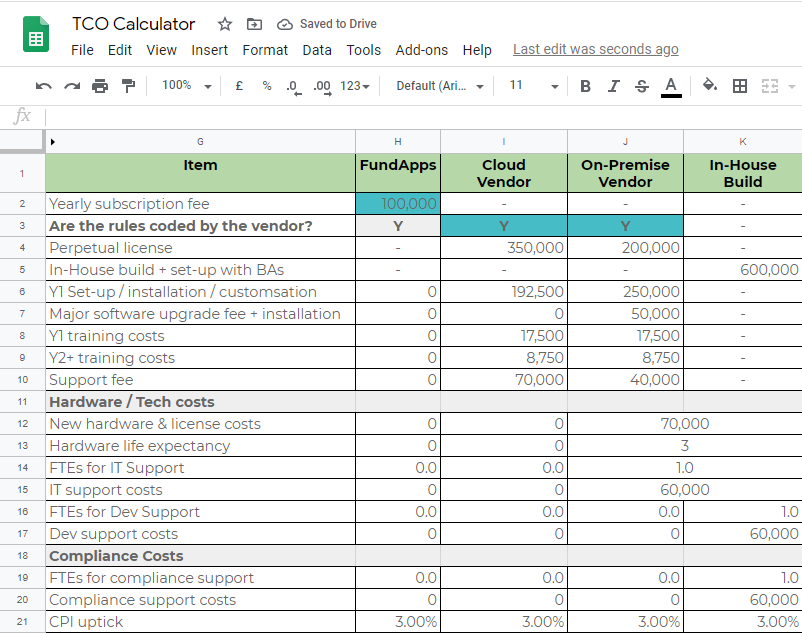In part 1 we looked at the total cost of ownership (TCO) for building your own (“BYO”) system. In part 2 we looked at your TCO for installing vendor software on your own servers (“on-prem”). In this post we will look at the likely costs you will incur if you choose to go with a Software-as-a-Service (SaaS) provider.
Since the early 2010s SaaS has become ubiquitous in the B2C world, and is becoming favoured over on-prem software in the B2B sphere. Services such as Salesforce, Workday and Office 365 have footprints in most modern enterprises and are expanding rapidly.
-3.jpg?width=1015&name=Cloud%20Tech%20(2)-3.jpg)
Part 3: Subscribing to SaaS from a vendor
The first caveat is to ensure that the subscription you choose covers all your requirements. As with your health insurance, gym membership or mobile phone plan there will probably be much small print on what is covered, what is not and what costs extra.
In the world of Shareholding Disclosure some of the things that might not be provided (and you would have to procure elsewhere / do manually) or could be a chargeable extra include:
- Rule coding: SaaS generally only includes the software and the hosting thereof. So the coding / updating of the required rules will often be left to you or can be a chargeable extra service.
- Global Coverage: Some vendors only cover 60 jurisdictions, some vendors charge per jurisdiction, some charge per region. Ensure that you license all the jurisdictions you need. But beware that for many regimes, disclosure is not based on the country of incorporation of the issuer, but where its shares are listed (see our post on the dangers of dual listing). Missing a required disclosure because a certain jurisdiction wasn’t licensed could prove to be a costly mistake.
- Takeover data: Some SaaS providers do not provide it, some charge extra for it. Takeovers change multiple times a day and the thresholds are usually very low - make sure that you automatically have the latest data and don’t have to do any manual work. Penalties for failing to disclose positions in takeover can be quite punitive.
- Articles of Association data: In France & Belgium, issuers can incorporate lower thresholds of disclosure in their AoA. Many vendors don’t provide this data, some charge extra for it. Again, this is vitally important data, as if you miss a disclosure to a French issuer there can be serious consequences.
- Onboarding: SaaS license fees should be the same every year (apart from inflationary uplift), but you may find some vendors charging an additional “onboarding fee” in year 1.
- Support: Some vendors charge for “premium support” or 24x7 support.
- Storage: Data storage is generally the most costly component for the vendor, so some may charge for storage over a certain volume or some may only guarantee keeping one year’s data online.
- Extra environments: Depending on your policies and future plans you may need additional environments to test certain things in. Find out how many environments are included and most importantly how much new environments cost.
Hidden Cost
The items listed above might have a dollar value attached to them, but more importantly consider the time spent by your own team. For example, how much of the SD process does the SaaS automate? Less than 50%? Or more than 90%? Likewise, does it need an experienced compliance officer to operate or can it be done by a trained operations person? This could mean the difference between two compliance officers spending 8 hours every day vs one operations person spending 4 hours. As you can imagine the internal cost difference between both scenarios is massive.
Similarly, ensure that you will be able to reach someone who can solve your support issues quickly and not just be passed on to a busy outsourced helpdesk somewhere. Spending an hour on-hold, listening to jingle bells is money out the window.
Finally, many [smaller] companies rely on expensive external counsel for nuanced, case-by-case guidance. Will your SaaS provider reduce that need and cost?
A vendor won’t give you an idea of these hidden costs so we’d recommend taking a reference call with a similar client to yourselves to ask questions about how much they estimate their internal costs to be.
CheapGym’s £30/month subscription might look like a better deal than SolidGym’s £50/m one, but your opinion might change once you realise that with the former you have to travel further, pay £1 for lockers, £5 a week extra for your favourite pilates class and they don’t have a swimming pool so you have to go elsewhere and pay £10 for the pleasure.
Implementation
SaaS means that there is absolutely no hardware or software to install. All functionality of the service will be accessed via a web browser, so once you have decided on a SaaS provider and subscribed, the implementation process can begin immediately.
With on-prem, the bulk of the implementation work will fall on the vendor. With SaaS the work will generally be with the investment manager. This means there are no external costs (unless your vendor charges an onboarding fee) and no dependencies on the vendor. You can go as fast as you want.
The duration of an implementation will depend on many factors. A small hedge fund with a handful of portfolios operating one entity and trading in a few jurisdictions can go live in a matter of months or even weeks. An investment bank with thousands of accounts/portfolios and hundreds of legal entities, with complex corporate hierarchies can take 2 years to be 100% live.
Ongoing Cost
Once you are live there should be no additional fees to pay on a yearly basis, a rough estimation below:
| Item |
Description |
Potential Cost Min Max |
|
| SaaS license |
License to operate the service for the period |
£40k |
£1000k |
| Possible extras |
|||
| Compliance Analyst (1 - 2) |
To encode the updated regulations into rules [As above, not every SaaS provider includes rule updates in their license fee] |
£60k |
£120k |
| £100k |
£1120k |
||
So a total of between £40k and £1,120M p.a. should be factored in for yearly running costs.
Security
While not directly linked with TCO, one must also consider how secure a SaaS solution is. Whereas with on-prem you are completely in control of your security, with SaaS there is a level of “trust” you must give the provider. In theory, SaaS can be provided by “2 coders in a garage” who have the servers under their desks, but in reality most serious players will be using a cloud service such as Azure, Google or the market leader - Amazon AWS. But, again using a household name hosting provider does not guarantee security. It is possible to host software in Azure but for it to be very insecure. Therefore we recommend considering the following when evaluating a SaaS provider:
| Evaluation criterion |
Motivation |
Importance |
| Are they SOC 2 or ISO 27001 accredited? |
If they are they will have undergone (and undergo on regular basis) very strict verification of their security and processes by an external auditor. |
High |
| Do they have other clients using their cloud SaaS? |
The more clients they have the more likely their security and processes have been evaluated previously. |
Medium |
| Standardised DDQ |
For example Cloud Security Alliance’s questionnaire will allow you to gauge the vendor’s security posture and see if they’re suited for you. |
If SOC 2 Low Else High |
Summary
If we compare the 5 year TCO from 1) Build your own, 2) On-Prem vendor and 3) SaaS:
| Service Type |
5 Year Min |
5 year Max |
5 year Avg |
| On-prem vendor solution |
£975k |
£8.0M |
£4.5M |
| Build your own (BYO) |
£1050k |
£6.0M |
£3.5M |
| SaaS solution |
£200k |
£5.6M |
£2.9M |
It’s fairly clear that both BYO and on-prem have very high fixed / initial costs (buying servers, building software, coding rules etc.) but that BYO starts to pay-off once up and running (no vendor fees to pay).
However, SaaS has the clear TCO advantage when it comes to very low upfront costs and low ongoing costs. Combine this with ease of use such as daily deployment of new functionality and bug fixes (not possible with on-prem) and a modern, secure architecture to build your compliance department around and it’s clear why SaaS is becoming the solution of choice for forward-thinking investment managers and banks.
Hopefully this series of posts has been useful in providing some insight to the questions you could and should be thinking about when embarking on a process to automate your shareholding disclosure process. If you'd like more information on our automated and SOC 2 certified SaaS solution or to see it in action then contact us here.
Please feel free to reach out to sales@fundapps.co if you’ve any questions about the differences between on-prem, BYO and SaaS or if you’d like a copy of our TCO Calculator.

If you haven't already, check out part 1 on the TCO of building your own system here and part 2 on the TCO for installing vendor software on-prem here.
